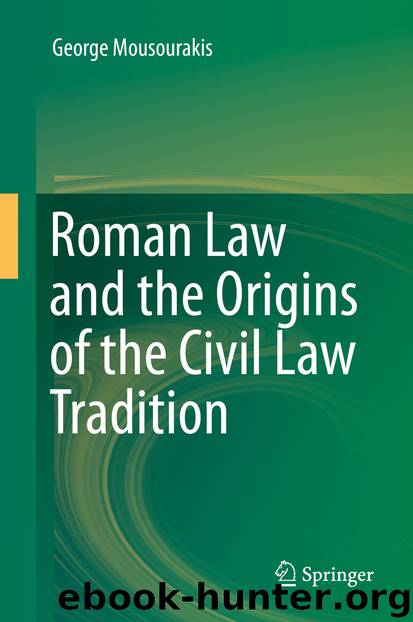Roman Law and the Origins of the Civil Law Tradition by George Mousourakis

Author:George Mousourakis
Language: eng
Format: epub
Publisher: Springer International Publishing, Cham
201The per formulam procedure was abolished by an edict of Emperors Constantius and Constans in AD 342. See C. 2. 57. 1.
© Springer International Publishing Switzerland 2015
George MousourakisRoman Law and the Origins of the Civil Law Tradition10.1007/978-3-319-12268-7_4
4. Criminal Law and Criminal Justice
George Mousourakis1
(1)Faculty of Law, University of Auckland, Auckland, New Zealand
4.1 Introduction
In modern law a distinction is drawn between delict (or tort) and crime, or between the delictual (or tortious) and criminal aspects of an act. In general, the distinction is between an act that violates an individual’s rights to his person, property or reputation and one that endangers the order or security of the state. The difference between delict and crime corresponds to the difference between the two principal objects the law is concerned with, namely redress and punishment. With respect to delict, the chief aim of the law is to compensate the injured party rather than punish the wrongdoer. With respect to crime, on the other hand, the principal aim of the law is to punish the wrongdoer with a view to preventing him and others from committing the same or similar crimes in the future and/or satisfying the public sentiment that wrongdoing must be met with retribution. As previously noted, in Roman law the corresponding distinction was between delictum and crimen. The term delictum or maleficium denoted an unlawful act that caused loss or injury to the person, property, honour or reputation of another. From this act there arose an obligation on the part of the wrongdoer to pay a penalty or compensate the victim for the harm suffered. The word crimen, on the other hand, signified a wrongful act that was directed against the state, or the community as a whole, and was prosecuted and punished by state organs. However, in Roman law the two concepts to some extent overlapped, since the law of delicts, besides being concerned with compensation for the victim, sought also to inflict punishment on the wrongdoer. This can be explained on the ground that the relevant penalty (poena) originated as the formalization of the primitive right to exact revenge and was imposed as a punishment on the wrongdoer that went not to the state, as in the ordinary criminal process, but to the victim. In Roman law the distinction between delict and crime mainly derived from the fact that with respect to the former case the victim could recover compensation and inflict punishment on the wrongdoer by means of a private action in civil proceedings and not through prosecution by state organs.
It should be noted that the criminal law holds a secondary place on the Roman legal scene. It was private law to which the Roman jurists devoted their main interest, and it was the private law that gave Roman law its great importance as a basis of much of modern law. It was not until the second century ad that Roman juridical literature began giving serious attention to matters of criminal law. Prior to that we have to rely mainly on literary sources, whose focus of attention is largely on the upper social classes.
Download
This site does not store any files on its server. We only index and link to content provided by other sites. Please contact the content providers to delete copyright contents if any and email us, we'll remove relevant links or contents immediately.
The Pirates of Somalia by Jay Bahadur(1587)
Political Theology by Carl Schmitt(1544)
The Holocaust: A New History by Laurence Rees(1486)
The Social Animal by David Brooks(1408)
A Practical Guide to International Arbitration in London by Hilary Heilbron(1395)
Restitution by Restitution(1393)
Pirates of Somalia by Jay Bahadur(1348)
Coercing Virtue by Robert H. Bork(1322)
The Nuremberg Interviews by Leon Goldensohn(1274)
Basic International Corporate Taxation by Sebastiano Garufi(1176)
A History Of Thailand by Baker Chris(1152)
International Trade and Business: Law, Policy and Ethics by Gabriël Moens & Peter Gillies(1107)
The Global Commons by Susan J. Buck(1106)
Asian Waters by Humphrey Hawksley(1094)
Blood Profits by Vanessa Neumann(1088)
The Sovereignty of Human Rights by Macklem Patrick(1076)
Spring Fever: The Illusion of Islamic Democracy by McCarthy Andrew C(1076)
The Nuremberg Trials: The Nazis and their Crimes Against Humanity by Roland Paul(1022)
Crimes Against Humanity: Historical Evolution and Contemporary Application by M. Cherif Bassiouni(997)
